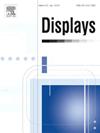Integrated dual-mode system of communication and display based on single-pixel imaging
IF 3.7
2区 工程技术
Q1 COMPUTER SCIENCE, HARDWARE & ARCHITECTURE
引用次数: 0
Abstract
The integrated mode of communication and display effectively utilizes spatial–temporal flicker-fusion property of the human vision system and the fast frame rate of modern display to achieve additional information transmission, and expands the application scene of visible light communication. However, the frame rate limitations of the camera and the asynchrony between transmitter and receiver seriously restrict the transmission rate and accuracy. In this study, we achieved the integration of communication and display within a single-pixel imaging framework by constructing the spatial–temporal complementary modulation mode and image display mode. Meanwhile, leveraging the characteristic of single-pixel imaging that detects only light intensity, and combining it with the image display mode, we developed an internal synchronization mechanism. This mechanism enables the precise extraction of data frames and the accurate reconstruction of transmitted data. The experimental results demonstrate that this scheme can achieve the transmission of additional information while provide high fidelity display. The image-to-data frame ratio is 8:1, and the maximum error-free field angle is 170°. Compared to other published methods, this scheme possesses a stronger noise resistance and a broader transmission range, which presenting a novel approach for integrated communication and display, and also extending application field of visible light communication.
求助全文
约1分钟内获得全文
求助全文
来源期刊

Displays
工程技术-工程:电子与电气
CiteScore
4.60
自引率
25.60%
发文量
138
审稿时长
92 days
期刊介绍:
Displays is the international journal covering the research and development of display technology, its effective presentation and perception of information, and applications and systems including display-human interface.
Technical papers on practical developments in Displays technology provide an effective channel to promote greater understanding and cross-fertilization across the diverse disciplines of the Displays community. Original research papers solving ergonomics issues at the display-human interface advance effective presentation of information. Tutorial papers covering fundamentals intended for display technologies and human factor engineers new to the field will also occasionally featured.
 求助内容:
求助内容: 应助结果提醒方式:
应助结果提醒方式:


